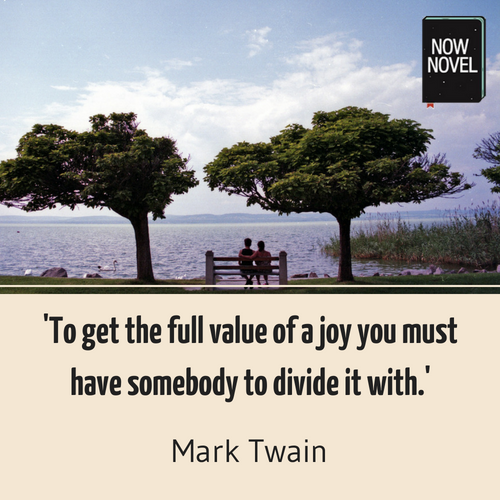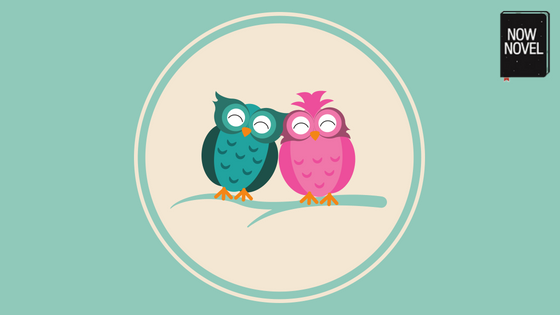Inspiration for romance story ideas is everywhere. From news headlines (TV actresses marrying members of the British royal family) to a sweet interaction you might witness in a restaurant. How can you develop a strong, affecting romance story idea? Read the following tips and use them to create interesting romantic arcs:
1. Build romance story ideas around romantic tension
The greatest love stories – from Tolstoy’s literary Anna Karenina to contemporary genre romance – intrigue us with romantic tension.
Ever watched a TV series that lost all momentum after two lead characters finally became a couple? That’s the effect of romantic tension diminishing. It’s a powerful source of forward momentum in a good romantic story.
Romantic tension is the suspense we feel as a result of characters’ developing romantic involvement. For example, we may feel suspense because:
- We don’t know if two characters will end up together, despite clear mutual attraction
- It’s unclear how characters will navigate bumps in the road to romantic bliss
- Interfering third parties (exes, family, jealous friends, or external circumstances such as war) get in the way of would-be lovers
In a well-developed romantic arc, the causes of romantic tension often change over time.
In Anna Karenina, for example, the married Anna has an affair with a younger man, Count Alexei Vronsky. Initially, romantic tension arises in Vronsky doggedly pursuing Anna. We wonder how she will respond to his advances. We also are aware of risk factors – the personal guilt and societal judgment that would result if Anna returned Vronsky’s passion.
Later, further tension stems from Anna admitting the affair to her husband. We wonder how this will affect the multiple parties involved. A further source of tension is introduced when Anna becomes increasingly anxious about Vronsky, questioning his fidelity.
Does your basic romance story idea contain a situation that is ripe for different romantic tensions? What keeps lovers apart, to begin? Their personalities? Competing desires? Uncertainties?
2. Find the desires driving your characters
When brainstorming a romantic story idea, think about the desires driving each character. Their past (backstory) and current circumstances will likely affect the romantic choices they make.
A character (like Anna K) might be in a loveless marriage, for example, at the start of a tragic romantic story involving spousal infidelity. The absence of intimacy in a current relationship might be the desire driving this character into the arms of another.
Common sources of romantic desire include:
- Physical attraction: The love interest is visually appealing, for whatever reason
- Intellectual or mental attraction: A character admires another’s mind, intelligence, values, world view
- Emotional attraction: Something about another character feels good – for example a character who is a born ‘giver’ enjoys nurturing a lover who is more vulnerable, and they enjoy the external source of strength
- Material attraction: A character can offer wealth, power, status or other benefits that fulfill their lover’s desires
If you think of the fairy tale ‘Cinderella’, what makes it a classic romantic tale is, in part, how the two characters’ desires and backgrounds fit.
The mistreated Cinderella, with her modest background, finds not only kindness but wealth too in the prince that further distances her from her unhappy background. The Prince finds beauty and qualities of kindness and other ‘noble’ characteristics that his money and aristocracy can’t necessarily buy.
To develop a romance arc, brainstorm plot points that bring your characters together. Reveal the ways each helps to fulfill the other’s most fundamental desires (comfort, security, or even just having a close friend and witness).

3. Throw your characters’ personalities into the mix
‘Chemistry’ – the way characters’ quirks, strengths, flaws, and desires work together (along with biological attraction) – plays a key part in romance. When brainstorming romance story ideas or romantic subplots, think about lovers’ personalities. What personality combinations or character archetype combinations make sense?
For example, there is some truth in the cliched saying ‘opposites attract’. For example, a character who is extremely organized could work well with a character who is a chaotic mess. The organized character’s strengths supplement the chaotic character. At the same time, the chaotic lover’s lack of control or abandon might appeal to the organizer, since it’s a side of themselves they don’t often explore or indulge.
Potential partners’ differences from us challenge our habitual ways of seeing and doing things. They might push us towards new adventures, mind-opening experiences that broaden our understanding. Thus ‘difference’ and ‘opposite’ qualities are often powerful in attraction because they supplement lack. This explains, in part, how lovers often describe their partners as their ‘other’ (or ‘better’) ‘halves’.
Characters who are very similar also have common ground for attraction, however. Two characters, for example, might be awkward and find comfort in the fact that the other does not judge them for their lack of social ease. A shared challenge contributes to their mutual liking.
In Roald Dahl’s darkly comical book for young readers The Twits, the marriage between Mr. Twit and Mrs. Twit makes sense because they’re both spiteful and cruel. They play twisted pranks on each other (Mr. Twit puts a frog in Mrs. Twit’s bed, while she tricks him into eating worm spaghetti). Together, they torment animals (and get their just desserts).
This shows how similarities in humour, interests or even unpleasant qualities can bond characters and explain their mutual choices.
4. Find potential conflicts in lovers’ differences
The same things that initially attract characters may become annoying.
For example, an artistic dreamer may be attracted to a wealthy financier. The financier is practical and business-minded. Perhaps the artist has to hustle hard just to make rent and there’s an element of comfort and security, too, in the match. The businessperson might in turn be attracted to the artist’s passion, vision, creativity, youthful energy or other qualities.
Although these differences attract characters initially, they can also be powerful sources of conflict. Perhaps, due to a practical nature, the financier constantly prioritizes work over their significant other. Maybe they don’t show up to an important occasion due to work commitments. This mismatch of focus/priority could be a source of friction and conflict.
Plot points such as these are useful because they show how characters evolve and grow to handle competing wants and needs (or fail to meet halfway). A little conflict often makes romance riveting. And it avoids the frustrating blandness of the ‘happy people in happy land’ effect, where characters are in a permanent state of romantic bliss. However you develop your story idea, make sure you include at least some conflict as this is true to the work that enduring relationships usually require.

5. Draw inspiration from romantic myths, symbols and pop culture
Myths, legends and modern pop culture alike are full of romantic images, lyrics, and ideas. Love and relationships are common themes in many songs. In Joni Mitchell’s song ‘All I Want’ she sings
‘I hate you some, I love you some/mostly when I forget about me’.
Take romantic lines such as these and imagine a situation that would cause a character to write (or say) this line, as an exercise. That could be a romance story idea in itself. The first line of the song is ‘I am on a lonely road and I am travelling’. The story could be about a solo female recording artist and her struggle to balance romantic relationships and her commitment to her art.
Download ‘How to Write Real Characters’ for exercises and tips for writing believable characters. Or join Now Novel and get constructive feedback on your romantic scenes and story ideas.


4 replies on “Romance story ideas: 5 tips for affecting arcs”
This is one of the most difficult things for me to write and these tips are fantastic. Thanks for sharing.
It’s a pleasure, again, thanks for reading 🙂
These are some great tips. Thanks a lot.
It’s a pleasure, I’m glad you found the ideas here helpful.